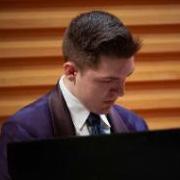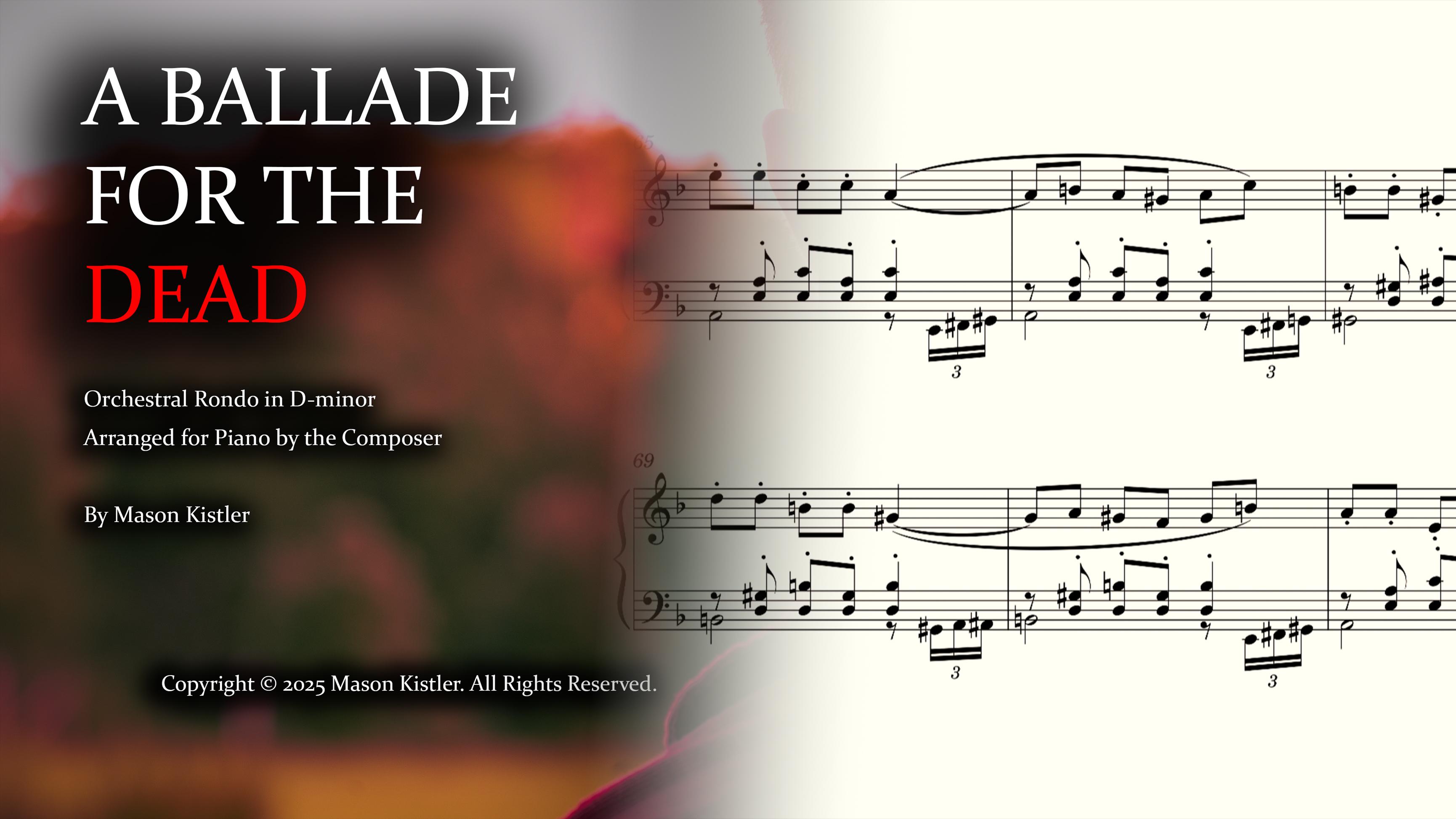-
Posts
24 -
Joined
-
Last visited
-
Days Won
1
MK_Piano last won the day on October 26
MK_Piano had the most liked content!
About MK_Piano

- Birthday June 21
Contact Methods
-
Website URL
https://www.masonkpiano.com/
Profile Information
-
Biography
Mason Kistler is an American pianist and composer pursuing a Master’s Degree in Piano Performance. Among his achievements are first place in the Spotlight on Talent competition (2020), a special certificate of composition from the Prague International Piano Festival (2024), and the premiere of his orchestral work Mountain Storms and Valley Peace at the Huntsville Young Composers Forum. Mason has also participated in masterclasses across Europe and the U.S. with esteemed pianists including Annie Cheng, David Kalhous, Stin de Cock, Svetozar Ivanov, and Anna Petrova.
-
Gender
Male
-
Location
United States
Recent Profile Visitors
The recent visitors block is disabled and is not being shown to other users.
MK_Piano's Achievements
-
MK_Piano started following Aos Sí - Piano Quintet for Halloween , WIP - First Piano Concerto (Feedback Wanted) , 2025 Halloween Satisfaction Survey and 3 others
-
Hey everyone. I have been going back and forth on my first piano concerto for a long time. Unfortunately, I reached a point where my original design has acted as a roadblock for me to finish the first movement. I decided to restart the work and compose from scratch. I will add more context below, however as an introduction, this excerpt is the entire exposition of my first draft. It is five minutes long and I wish to have it preserved here on YCF. So, sit back, and follow along to the work-in-progress of my first concerto! 🎹 ________________ CONTEXT AND FEEDBACK: I started this project back in June 2024 when I improvised the first theme in one of my practice sessions. I fell in love with it and immediately knew I found a theme worthy for a concerto. I am sticking to late classical (and possible romantic hints) for this work. Hummel, Shostakovich, and Rachmaninoff are the main three sources of inspiration for my orchestration. It follows Sonata-form, however using three themes (1st, 2nd and closing theme) in the exposition. Recently, as I have been diving heavily into the works of Mozart, Haydn and Beethoven, it has dawned on me the level of sophistication each composer had in their writing. How Beethoven would use elements of the first theme to make his second theme, and later use the first movement as basis for theme and variation writing or fugal writing in his third movements. So, after a break in the first half of the year, I have been looking at this exposition and tried to add sophistication. However, I noticed so many gaps in the structure. As it stands, it feels like a compilation of several themes versus one long work showcasing the transformation of the motif and form. As a result, I have stopped working on it and grabbed a blank manuscript and wrote down the key three themes I want to use. I have yet to start rewriting, as I want to give my brain a break and simply ask for feedback. I would appreciate comments on form, orchestration and anything you deem fit. Please do not hesitate to be blunt either! (I may try to write pure double exposition instead of this quasi-expo before the first piano cadenza.) Thanks in advance!! 🙂 _________ EDIT: There is no English Horn in this work so far. I used my Orchestral template and forgot to remove the English Horn from the instrumentation page. Also, The score is NOT TRANSPOSED; it is a concert score)
-

2025 Halloween Satisfaction Survey
MK_Piano replied to PeterthePapercomPoser's topic in Monthly Competitions
@PeterthePapercomPoser @Thatguy v2.0 Thank you for the replies! By no means did I mean to dissuade the structure you implemented. You cannot conform to everybody and no competition is going to be "fair" for every entry. You will have to find a system that is both fair, and not overly strict. I believe my logos was not as clear as I intended in my previous reply. Two things can be true at once and it is refreshing to see many different musicians advocate for a low-pressure means to simply write music; or share existing creations they feel have merit. At the same time, I do not want to take away from the people who are less experienced trying to throw in their works with professional composers. I do not see it fair if they do. As you hinted for the next possible event to be a Christmas one, with no limit on ensemble size, would it make sense to lump and judge a symphonic orchestra work to a solo sonata with piano accompaniment? Or a digital work to a sacred-vocal work detailing a hymn? This was the basis of my thinking in my OG reply. I simply wonder if there is a mesh between formal and informal. Here was an alternate take on my idea(s): Keep the judging by poll, and limit the votes to categories; as you did. With using a table for review, I wanted to suggest another addition to all the info you provided. You added a table showcasing the scoring system (7-7.9 = Average / Standard ). I meant to suggest adding a diagram that defines the words being used: Taste, Originality, Textures, Score Presentation, etc. Taste - Your personal score from 1-10 Score Presentation - How the score is organized / How easy it is to understand the score from 1-10 Originality - How unique does this score sound from 1-10 Creativity - How well the submitant made and used a theme from 1-10 etc. I thought it to be a good way to avoid confusion of the terms by defining the language you want to use. I do not believe that add-on to take away the fun aspect of this. Thanks again! -

2025 Halloween Satisfaction Survey
MK_Piano replied to PeterthePapercomPoser's topic in Monthly Competitions
I just finished my little vote. I had a fun time, even if I didn't "win," I still feel I gained some experience. Heck, it gave me a passion to make new music and make more music of similar instrumentation. I was happy to see that I was not the only one who did a Piano Quartet with Strings to pair. It was refreshing to hear how different 3 people can make contrasting music with the same constraints. I will reference them in the future when it comes time to do more. 🙂 About the grading or reviewing aspect, I think a simple solution is to keep brackets or divisions for submissions. We saw a complete mix of tonal and post-tonal, amatuer and professionals. It can be hard to grade them all at an equal level when you have to conform yourself to a different standard for each person. I want to be the first to suggest this idea: I think before the next competition, you should categorize users by division based on an entry poll or application. Like most real festivals, forums or competitions, each user will have to file an application to enter with their work. Some places in the US are now asking for cover letters and resumes to pair. Since the point is to keep it fun and more informal, I suggest making a poll asking for people to help gauge their experience: "Have you seen your works performed?" "Have you taken music theory before?" "How many years have you been writing music? "Do you have the ability to write sheet music?" "Will you submit a post-tonal (Without key-center) or tonal (with key-center) work for this event?" Etc. Similar to existing competitions, we can categorize people before hand, create divisions and judge more accurately. Some divisions such as the following: Amatuer Professional Post-Tonal Tonal This was my only gripe with the formatting. It felt hard to review everyone to a level standard when the goal-post was never consistent. I do not want to feel like the bad guy for using language or concepts they are not aware of, or risk being redundant if it is clear they have experience. The table used for reviewing was a little vague as it felt more subjective. I do not mind that when rating music, however, it may be nice to specify what you mean by "Originality" or "Textures". Someone may have a different understanding of what those words mean and it will affect their reviews. Defining some of them beforehand will also standardize the ratings. Thoughts? 🤔 -

2025 Halloween Competition - DANCE FROM THE SKELETON BALL (Submission)
MK_Piano replied to MK_Piano's topic in Chamber Music
Thanks for the feedback! As a little lore to this, I originally wanted to write for Piano Quartet using the woodwind families. I started music on the Bb-Clarinet, and in college, became the Principal bassoonist for our symphonic band for two semesters. When beginning to write, I was really inspired by the Nightmare Before Christmas and Danny Elfman as a whole. However, I just never found any concrete ideas with this instrumentation. It all felt too stereotypical. Thus, I went even more traditional and back to the orchestral setting for this work. I never thought about another name. One user suggested increasing the tempo slightly, and there more I listen back, there more I am beginning to agree with it. I don't have any new ideas for a name, but after this contest concludes, I may revisit it, add those changes, and change the name. Maybe, while I am at it, add another movement or installation and make it a chamber set. Thanks again! -

2025 Halloween Competition - DANCE FROM THE SKELETON BALL (Submission)
MK_Piano replied to MK_Piano's topic in Chamber Music
I appreciate the feedback!! I'd love to talk more about some of the theory behind elision(s) when applied to structure. I felt that if I did a pure 4-bar phrase, it would become too stagnant due to all the repetition. As I wanted to keep your attention, I Elided the violin to carry the listener into new directions. I will admit most of my choices in this piece came from a point of wanting rich sound and low registers. I thought that going high in each instruments tessitura would not benefit the character I was striving for. To add, I was pressed for time in my already busy schedule, and I did not feel it worth to aim for complex development of the motivic structure. I did try to keep it simple instead of going for a level of sophistication that would take me a few weeks -> months to really refine. Structurally speaking, I employed transition phrases to connect either a new texture change or section of the piece. Measures 21-24 and 33-37 are such places. It was for these moments where I did not want to exercise new motives, but as I type this, I see this now it could've been a chance to do a dependent transition and allow the motif or texture to start developing as or before the third statement of the theme comes in the Piano. The development is when I broke the classical mode and tried to create a section purely for the effect of Halloween. I wanted something not active in texture to contrast the opening and just go for simplicity at it's finest. Also, not too much I can do about similarities to other works. There are only so many keys and I really wanted to use C-minor for this lol Thanks for the comments, it has given a lot to think about. -

2025 Halloween Competition - DANCE FROM THE SKELETON BALL (Submission)
MK_Piano replied to MK_Piano's topic in Chamber Music
@UncleRed99 I can understand some of the confusion. As this was created and submitted for this Halloween event, my original goal was to make a skeleton dance. I was explicit in conveying that in the title and the brief description of the work. For some context, yes, I did mean to use “Esultante” to convey a jubilee as you are hearing the music from this dance reach a close. We are hearing the music from this grand gala. However, what is “chaotic” to us is fun for them as the “DJ” or Host raises the energy to close the party. To your point about the articulation in the cello, there comes a point in performance practice where you find out that articulation markings also convey bowing information. There are multiple ways to play a staccato within the string family (on or off the string staccatos). The context of the works implies that they need to lift or bounce the bow off the string and attack for the slur with another, single-bow movement. In the context of the work, they will bounce between their C and G strings respectively. In terms of blurriness of the chromatic notes? Clarity and hearing each individual note is not the intention, as it is meant to convey a little “rush” or “wisp” motion into the downbeat(s). Thanks for the comments. -

2025 Halloween Competition - DANCE FROM THE SKELETON BALL (Submission)
MK_Piano replied to MK_Piano's topic in Chamber Music
Yeah, it feels nice to have someone else notice those decisions. In all honesty, I did not realize the Viola never had the melody until I did the A-minor Modulation lol So, I tried a solo Viola part at the section, but I know if played live, it was going to get lost in the heavy texture at Forte. So, I doubled it with the Cello to support as the Piano was doing the bass pattern. Also, 100% correct on the enharmonic spelling in the Viola, it was purely for voice-leading purposes versus trying to imply a different harmonic function. Thanks for the comment! 🙂 -
@Omicronrg9 That was a long reply, so I may just focus on one aspect versus all of it lol. In all of the accompaniment work and chamber playing I have done, I would say most, if not all, of the scores had smaller staves for non-piano parts. I will attach a collection of links from IMSLP showcasing Piano trios from Mozart and Beethoven. Both Henle-Verlag and Bärenreiter-Verlag use reduced staves. Since smaller works do not need a conductor, the pianist usually gets the full transposed score. Allows us to follow along and coordinate with the musicians more specifically. With the stave spacing, I feel I should clarify that it is fine to read as is. I have no issue following along with it of course. It was more of a taste comment versus a "better or worse" comment. In my personal style, I like to space the staves by three to six measures if able. I think seeing it a little bigger on the paper can be easier for the performers eyes. Myself and other peers read our music off a tablet and use a bluetooth pedal to turn the pages. So for me, page turns are not an issue if there are more pages. Lastly, with system dividers, again, it's a preference. You'll see on these IMSLP scores that even big-publishers will put some kind of measure indicator. On ASCAP and J.W. Pepper, composers will use rehearsal marks. On IMSLP, publishers will put system numbers or sometimes measure numbers every 10-measures. If they are doing it, why can't we? I recommend other composers to put some kind of measure marking as we have to remind ourselves that other people will be playing the music with no previous understanding of it. It's a small cosmetic change that doesn't affect the music, but will add a convenience to anyone who plays our work. If you were to compare to mine, I go so far to ensure that a new rehearsal mark goes at the beginning of a new system when I can. A little visual detail that coincides with any new idea or important spot in the score. At the end of the day, this is some food-for-thought! 🙂 IMSLP: Mozart | Trio in C-major K.548 Beethoven | Trio in Eb-major Op.1 no.1 Beethoven | Trio in Bb-major Op.11
- 18 replies
-
- 4
-

-

-
I must confess, that with enough time, it could be possible for myself or peers to sit down and play this. However, mainly because myself and my friends are high-in-skill concert pianist's capable of complex repertoire. My logos in thinking comes from the idea of the music being "theoretical" or "practical". In my opinion, practical music is a lot stronger than "theoretical" music. While on surface level/ on paper, this score seems possible in theory. This does not mean it is the most practical or effective way to write the music. You have to keep in mind the type of performer capable of playing this. Humans need time to move the hand, their fingers, turn the page, and more. A high schooler or middle school pianist will not be able to play this unless they have had extensive training. Even I hesitate to pick it up because simply be looking at the music, and comparing it to all the music I have played, I can tell it will be uncomfortable to play in certain spots. If I were to give this to my mentor, who is a student descendent of Chopin, he would never play 4 note tremelos, only 3 notes long and switch. On the trill variation (no.3) he, and myself, would only play the trills as mordends versus proper quarter note trills. This said, challenging music is okay to make, as you can't write music to conform to everyone. Two things can be true at once, and while it may be a challenge to play, it is also uncomfortable for the average pianist. To end, your ideas are good/ fine, and I don't mean to say this piece has no merit. Instead, if you were to ask 3 musicians to sit and play this, they would have a tough time and may ask you if changes in their part would be okay.
-

A hollow theme for Halloween (Fall 2025 competition)
MK_Piano replied to therealAJGS's topic in Electronic
It depends on your goal. Your intuition allowed you to make a piece of music that a normal person would say sounds fine/ cool. For a more refined level, you can take that intuition and apply things like chords or melody structure. All of which will allow you to replicate your work more consistently versus "doing so because music theory is essential for writing good music". If you want a free, collegiate-level, link to start learning music theory, consider checking out Music Theory for the 2st Century Classroom. This site is the one I used as a Freshman and Sophomore. It's pages of music fundamentals to complex theory; it is also paired with exercises and worksheets for when you want to practice these skills. -

YCF Composition Competition - Halloween 2025 (Submission)
MK_Piano replied to UncleRed99's topic in Chamber Music
Hey Red! I've been making it goal to comment at least once on the halloween submissions and here I am! In our separate conversations, we have already spoken a lot on the piece, from how you created it, to how a new key/ scale can affect it, and how engraving can make or break a musicians understanding of the work. For those who have known your previous works over the last few months -> year, there is a clear sophistication in this work. I can see the clear sense of structure and harmonic language you presenting and I cannot state that enough. In the halloween sense, I am a big fan of the little dance after the A-section. It is very fun to listen to. Good work my friend! Let this only be a stepping stone to your greater works 🙂 -
What a wonderful piece of music. Musically speaking, I greatly appreciate your abilty to develop the motif over the course of the work. It was entrancing and even went it felt dissonant, I was listening with intent. I do have specific critiques on the engraving/ format of the score: I think it would be a better decision to increase the margins of the entire score. All printers have a margin where they will not put any ink on the outside of the paper (This is called the bleeds). If you were to view your PDF and hit the print button, it will automatically update the margins. (I have attached two screenshots to show this). I also think you can space out the measures more in certain spots (mm.31-58) even when instruments are playing. A pianist would read a part with all 3 instruments on there to help with coordination and having it spaced out may be a nice convenience. Lastly, I recommend adding system dividers to separate the score and to add rehearsal marks so one day, a trio can actually rehearse and use specific places in the score to practice. Lovely video to accompany this as well! 🙂
- 18 replies
-
- 4
-

-

-

Aos Sí - Piano Quintet for Halloween
MK_Piano replied to HoYin Cheung's topic in Competition Hall of Fame
In the modern landscape, this, to me, was refreshing to listen to. I have experienced listening to bad post-tonal works where my peer thought more noise and crazy writing benefited the music or hall being played. I appreciate the landscape you painted and would not mind listening to this again in the future. Of course, on an objective level, this piece is difficult. I think it would be effective when played live, however, I would be the one to pass off learning it and give it to the next musician due to the ensemble difficulty lol. When applying it to Halloween, I think you have succeeded. Maybe not in the terms of the 'trick or treat' or lighthearted celebration that happens each year, but in terms of capturing the eerie and scary images a haunted house or creepy film shows. Good work!


.thumb.png.1e2763f479362bbb522da50d31ef2e50.png)


